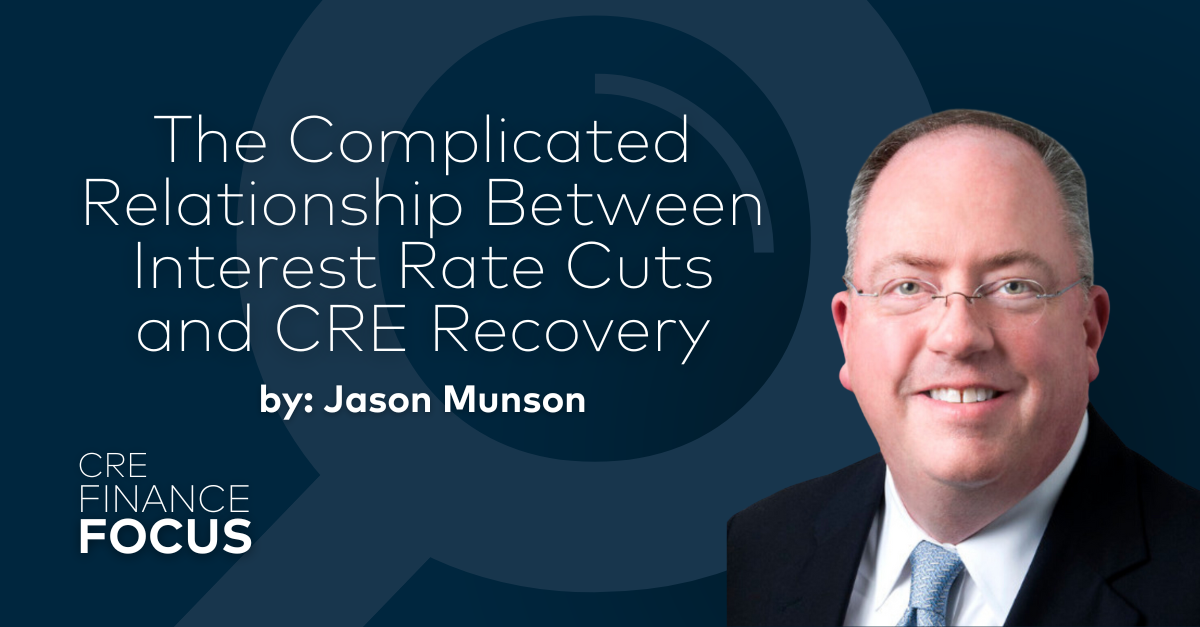
By Jason Munson
Managing Director of Relationship Management, Client Services
Few industries have been impacted as significantly by the recent, unprecedented rise in interest rates than commercial real estate (CRE). The Federal Reserve increased the federal funds rate by 525 basis points (bps) between March 2022 and July 2023 (from 25 bps to 550 bps) with the stated goal of fighting persistent inflation, significantly increasing the cost of capital, particularly on floating rate debt, and reducing transaction volume as CRE market participants were forced to adjust to the new environment. The aftershocks of rate increases are still reverberating through the industry, evident in higher borrowing costs, elevated cap rates and reduced property valuations. These factors have led to significant “bid/ask” spreads between buyers and sellers, as well as difficulties for property owners attempting to refinance maturing loans.
Ever since rates began to rise, there has been endless speculation about when rate cuts would commence. Because what goes up, must come down, right? Unfortunately, the laws of physics do not apply to the world of finance and any future downward adjustment in the fed funds rate may not have the immediate beneficial impacts that CRE participants are anticipating.
While numerous studies have demonstrated a close correlation between Fed funds rates and short-term interest rates (specifically one- and two-year Treasury bonds), the relationship between fed funds rates and longer dated 10- and 30-year bonds is much less clear. Given that most CRE debt pricing is based on either the ten-year Treasury bond or SOFR (Secured Overnight Financing Rate), the impact of any future fed funds rate increases or decreases might not be as direct or clear as the market is anticipating. So, if the Fed cut rates by 100 basis points this year, as many are speculating, what would be the practical impact of CRE industry? Would market conditions significantly improve?
Unfortunately, the answer is no. While reduced borrowing costs would undoubtedly be beneficial to some, property owners have faced significant cost increases over the past couple of years, particularly on insurance coverage, which is one of the highest operating expenses behind property taxes and utilities. Premium increases of up to 100% or higher are becoming commonplace, especially in states prone to incur natural disaster claims. In fact, a recent study concluded that increased insurance premiums alone have eroded property valuations anywhere from 4%-11% just the past two years.
However, interest rate cuts may have a more indirect, albeit powerful, impact on the CRE market with respect to investor sentiment – after all, equity capital is the oil that keeps the wheels of the CRE industry turning. Gordon Gekko famously said, “money never sleeps” so capital allocators have sought more stable and reliable return vehicles to replace CRE investments over the past couple of years as market cap rates lagged “risk free” Treasury Bond returns. As interest rates potentially moderate and enhance CRE return metrics, investors will increase CRE allocations and transaction volume will increase accordingly.
While it’s difficult to quantify something as ambiguous as sentiment, there is growing optimism among institutional investors and lenders (as reflected in recent Q2 earnings calls) that the market may have found a bottom, and that lease and sale transactions are expected to increase. Whether this plays out remains to be seen as much of the deal volume the past year or so has been attributable to large portfolio transactions by institutional players, most notably Blackstone and KKR, with small to medium-sized sponsors and investors remaining on the sidelines.
It is interesting to note that Blackstone recently published a chart showing that Great Financial Crisis property valuations bottomed in June 2009 but did not fully recover until four years later in March 2013, indicating that positive investor sentiment typically lags the market bottom by a wide margin. Any moderation in interest rates could serve as a positive signal to investors that the time is ripe to re-enter the CRE market, which would benefit all market participants.
Jason Munson, Managing Director of Relationship Management at Trimont, has 28+ years of experience in senior and executive roles within institutional real estate firms, specializing in asset management, investment underwriting, acquisition and development due diligence, loan servicing, and debt and equity recapitalizations, and has successfully managed and disposed of multifamily and commercial assets.
CRE Finance Focus is Trimont’s bi-weekly LinkedIn newsletter delivering distinct perspectives on the most pressing topics of today from industry experts. Keep your finger on the pulse of the #CRE market and subscribe today.
If you have questions about navigating the current CRE landscape, contact us at info@trimont.com.
Have questions or topics you would like to see covered? Submit them here.

About Trimont LLC
Trimont (www.trimont.com) is a specialized global commercial real estate loan services provider and partner for lenders seeking the infrastructure and capabilities needed to help them scale their business and make informed, effective decisions related to the deployment, management and administration of commercial real estate secured credit.
Data-driven, collaborative, and focused on commercial real estate, Trimont brings a distinctive mix of intelligent loan analysis, responsive communications, and unmatched administrative capabilities to clients seeking cost-effective solutions at scale.
Founded in 1988 and headquartered in Atlanta, Trimont’s team of 400+ employees serves a global client base from offices in Atlanta, Dallas, Kansas City, London, New York and Sydney. The firm currently has USD 236B in loans under management and serves clients with assets in 72 countries.